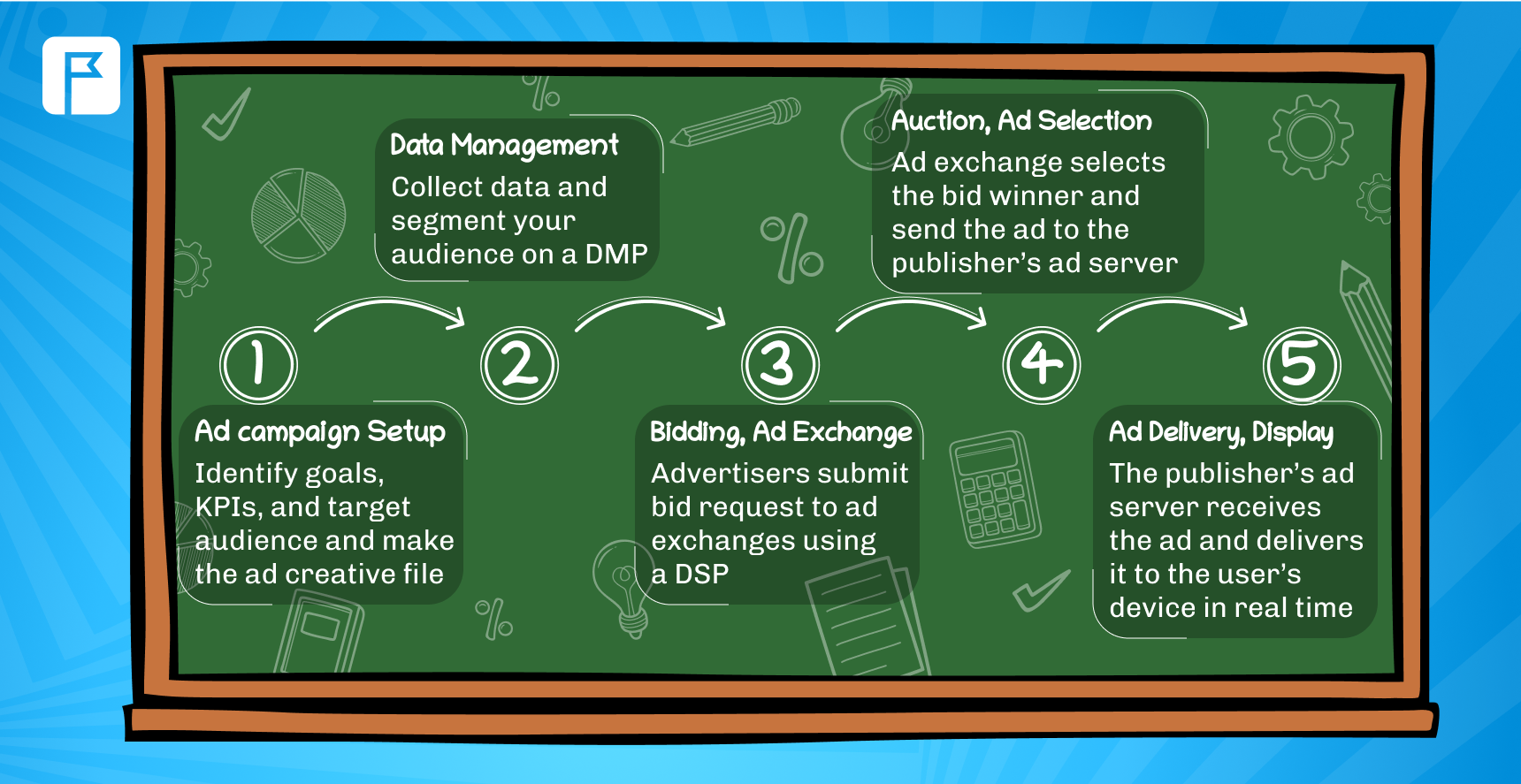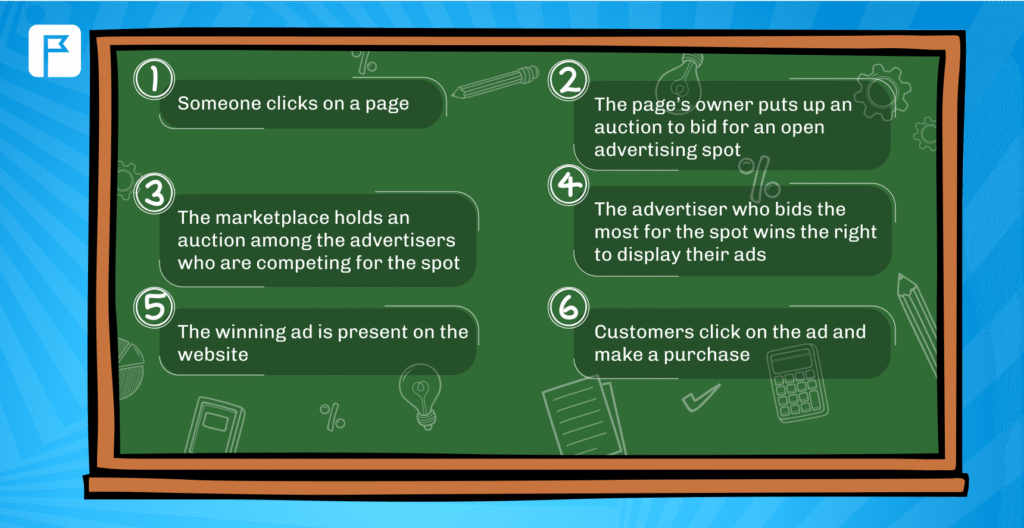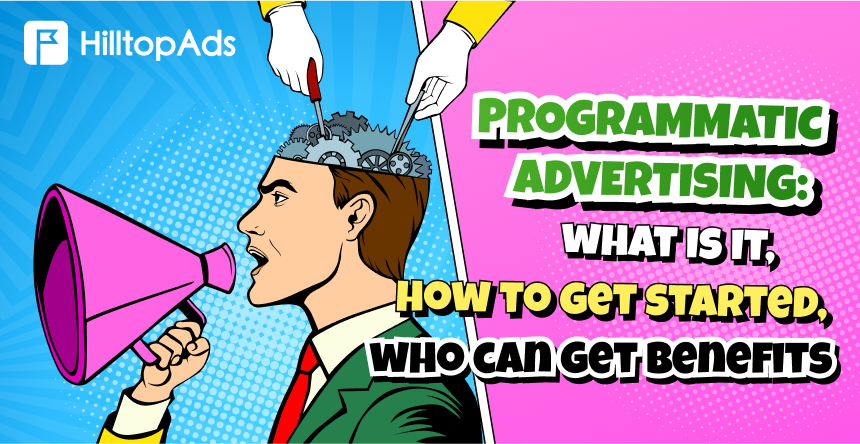Non siete sicuri di cosa sia la pubblicità programmatica? Forse siete curiosi di sapere quanto possa essere impegnativo o costoso incorporarlo nella vostra azienda. O forse vi state chiedendo se si adatta bene ai vostri obiettivi aziendali.
Questa guida spiega tutto quello che c'è da sapere sulla pubblicità programmatica, che consente di trovare e visualizzare gli annunci proprio quando sono più rilevanti per il vostro pubblico.
Cos'è la pubblicità programmatica: Significato, storia, ruolo nel marketing digitale
La pubblicità programmatica è l'utilizzo di software per l'acquisto di spazi pubblicitari digitali. A differenza di alcuni metodi che richiedevano richieste manuali, preventivi e lunghe trattative, i sistemi programmatici utilizzano algoritmi per acquistare e vendere automaticamente spazi pubblicitari online.
<La tecnologia programmatica risale ai primi anni 2000. Il 1994 è l'anno in cui è stato visualizzato il primo banner pubblicitario con un tasso di clic impressionante (44%), sebbene non disponesse di funzionalità di targeting particolarmente valide. Si arriva rapidamente al 2000, quando Google ha lanciato AdWords, che alla fine si è trasformato nella Rete Display di Google nel 2013. Nello stesso periodo, aziende come Google AdEx, Microsoft AdECN e Right Media di Yahoo hanno sviluppato software di offerta in tempo reale, gettando le basi per quella che oggi conosciamo come la moderna pubblicità programmatica.
Nel marketing digitale, gli strumenti programmatici si occupano della parte più complessa dell'acquisto degli annunci, liberando gli addetti al marketing per concentrarsi sulla creazione di annunci migliori. È diventato una parte essenziale delle strategie di pubblicità online, con una spesa programmatica globale che si prevede raggiungerà l'incredibile cifra di $800 miliardi entro il 2028, secondo Statista.

Create annunci di alta qualità con HilltopAds!
Come funziona la pubblicità programmatica?
La pubblicità programmatica mette in contatto due gruppi principali: gli editori con siti web con spazi pubblicitari da vendere e gli pubblicitari che vogliono acquistare tali spazi.
Ecco il procedimento in semplici passi:
- L'utente clicca sul link: Quando qualcuno visita un sito web, il sito invia una richiesta di inserzione con informazioni sul visitatore.
- Apertura degli spazi pubblicitari: Il proprietario del sito web mette all'asta gli spazi pubblicitari attraverso una piattaforma di offerta (SSP).
- Il pubblico viene abbinato: i dati dei visitatori vengono abbinati agli pubblicitari disponibili.
- Gli inserzionisti fanno offerte: Gli inserzionisti sulle piattaforme demand-side (DSP) propongono offerte per gli spazi pubblicitari.
- Offerta Top Vince: Il miglior offerente si aggiudica lo spazio pubblicitario
- L'annuncio porta traffico: L'annuncio appare sul sito web per essere visualizzato dal visitatore

Questo processo avviene in soli 0,1 secondi, più velocemente di quanto si possa battere le palpebre! Il sistema programmatico utilizza l'intelligenza artificiale per decidere quali annunci mostrare in base a ciò che conosce del visitatore, rendendo gli annunci più pertinenti.
Canali pubblicitari programmatici nel 2025
La pubblicità programmatica funziona oggi su molti canali diversi, il che aiuta gli pubblicitari a raggiungere il proprio pubblico di riferimento in vari modi.
Annunci display
Sono gli annunci programmatici più comuni. Gli annunci display appaiono nelle intestazioni, nei piè di pagina o nelle barre laterali dei siti web. Possono essere aggiornati e personalizzati in base ai dati degli utenti, il che li rende più efficaci degli annunci statici. I sistemi programmatici possono inserire questi annunci su migliaia di siti web che corrispondono al vostro pubblico di riferimento.
Annunci video
La pubblicità video attraverso i canali programmatici è destinata a raggiungere $436 miliardi entro il 2026 e continuerà a crescere. Esistono tre tipi principali:
- Annunci in-stream: Vengono visualizzati prima (pre-roll), durante (mid-roll) o dopo (post-roll) un video.
- Annunci out-stream: Appaiono all'interno degli articoli o come pop-up
- Annunci in-display: Vengono visualizzati nei risultati di ricerca o come raccomandazioni di video sponsorizzati.
Il video continua a essere uno dei formati più coinvolgenti, con la programmazione che rende più facile posizionare i video dove il vostro pubblico li vedrà.
Annunci sociali
Le piattaforme di social media come Ig, TikTok, Fb e X (ex Twitter) supportano la pubblicità programmatica. Questi annunci possono essere acquistati tramite API o attraverso piattaforme demand-side che si connettono a queste reti. Gli annunci sociali aiutano a raggiungere i membri dell'audience dove trascorrono molto tempo online.
Annunci nativi
Gli annunci nativi si integrano nel sito web su cui appaiono, creando una migliore esperienza per l'utente. Invece di risaltare come i banner pubblicitari, sembrano contenuti naturali. <Possono comparire annunci nativi programmatici:
- Alimentazione pur avendo l'aspetto di articoli su pagine editoriali
- In-article all'interno di paragrafi di contenuto
- Come raccomandazione widget per contenuti simili
- Nei risultati di ricerca, che assomiglia alle inserzioni organiche
Annunci audio
La pubblicità audio è diventata un importante canale programmatico con la continua crescita dei servizi di streaming e dei podcast. Piattaforme come Spotify e Pandora offrono opzioni programmatiche per raggiungere gli ascoltatori con messaggi audio mirati.
Annunci In-App
Dato che le persone trascorrono 4-5 ore al giorno sulle applicazioni mobili, la pubblicità in-app è diventata essenziale. Gli annunci in-app programmatici includono:
- Banner bloccati in basso che rimangono in vista
- Interstitials che appaiono tra le azioni dell'app
- Annunci premiati che offrono vantaggi agli utenti che li visualizzano
Note dell'esperto:
Provate 2-3 tipi di annunci diversi contemporaneamente per vedere quali funzionano meglio per voi. Assicuratevi di creare annunci adatti a ciascun tipo.
Scegliete il vostro mix in base a:
- Gli annunci display sono comuni e funzionano per la maggior parte delle aziende, ma a volte le persone li ignorano.
- Gli annunci video ricevono più attenzione, ma costano di più per essere realizzati e gestiti
- Gli annunci nativi hanno l'aspetto di un normale contenuto del sito, quindi le persone li notano di più.
- Gli annunci audio funzionano bene perché sempre più persone ascoltano podcast e musica in streaming
- I cartelloni pubblicitari digitali e lo streaming televisivo sono ottimi per raggiungere le persone quando non sono al computer o al telefono.
La maggior parte delle aziende si comporta al meglio con un tipo di annuncio principale, che permette di ottenere vendite o contatti, e con altri tipi di annunci che aiutano a far conoscere il proprio marchio.
Ecosistema della pubblicità programmatica: Comprare, vendere, altre piattaforme
L'ecosistema della pubblicità programmatica funziona come una borsa degli annunci, con diverse piattaforme che gestiscono ruoli specifici.
Piattaforma lato offerta (SSP)
Un SSP detiene l'inventario dell'editore e aiuta i proprietari di siti web a vendere efficacemente i loro spazi pubblicitari. SSP:
- Collegare gli editori a più scambi di annunci, reti e DSP
- Tracciare il comportamento dei visitatori attraverso il codice inserito nella pagina
- Aiuta gli editori a stabilire le tariffe e a filtrare gli annunci per pubblico.
- Lavorare per massimizzare il valore che gli editori ottengono dai loro spazi pubblicitari
Gli editori utilizzano le SSP per controllare chi può acquistare i loro spazi pubblicitari e a quale prezzo, assicurandosi che il loro inventario venga venduto alla migliore tariffa possibile.
Piattaforma lato domanda (DSP)
<Gli inserzionisti utilizzano le DSP per acquistare spazi pubblicitari su molti siti web contemporaneamente. DSP:
- Fare offerte automatiche in base ai parametri della campagna
- Utilizzare i dati sull'audience per rivolgersi alle persone giuste
- Connettersi a più ad exchange e SSP
- Fornire rapporti sulle prestazioni della campagna
Le DSP aiutano gli pubblicitari a trovare i luoghi migliori per mostrare i loro annunci al loro pubblico di riferimento.
Piattaforma di gestione dei dati (DMP)
Le DMP raccolgono e organizzano i dati provenienti da diverse fonti per contribuire al targeting degli annunci. Essi:
- Combinare dati di prima parte (dal vostro sito web), dati di seconda parte (dai partner) e dati di terza parte (da fonti esterne)
- Creare profili utente dettagliati per il targeting
- Aiutare i pubblicitari a capire meglio il loro pubblico.
- Alimentazione delle informazioni di targeting alle DSP
Una buona DMP rende più efficace l'acquisto programmatico garantendo che gli annunci raggiungano le persone giuste.
Scambi di annunci
Gli Ad Exchange sono mercati digitali in cui avvengono le transazioni programmatiche . Mettono in contatto acquirenti e venditori, consentendo loro di completare le transazioni in tempo reale. Gli ad exchange più diffusi includono:
- Scambio di annunci di Google (AdX)
- AprireX
- AppNexus
- Progetto Rubicone
Queste piattaforme facilitano il processo di offerta, mettendo in contatto gli pubblicatori con gli editori.
Reti pubblicitarie
Le reti pubblicitarie mettono in comune gli spazi pubblicitari invenduti da molti editori e li vendono a inserzionisti a tassi prestabiliti. Anche se non strettamente programmaticoLe reti pubblicitarie si collegano spesso alla programmatico ecosistema. Essi:
- Aggregare l'inventario di più editori
- Offrire opzioni di acquisto semplificate per gli pubblicatori.
- Spesso si concentrano su tipi specifici di inventario o di pubblico
Le reti pubblicitarie possono essere un modo più semplice per acquistare annunci su più siti.
Provate a lavorare con la rete pubblicitaria HilltopAds
per semplificare la vostra strategia pubblicitaria e iniziare a guadagnare di più!
Server pubblicitari
I server pubblicitari assicurano che gli annunci vengano consegnati correttamente. Essi:
- Archiviare i file creativi degli annunci
- Trasmettere gli annunci giusti ai posti giusti
- Tracciare impressioni e clic
- Fornire report sulle prestazioni degli annunci
I server pubblicitari sono la spina dorsale tecnica che assicura la visualizzazione dell'annuncio giusto dopo l'aggiudicazione di un'offerta.
Pubblicità programmatica: Pro e contro per i marketer digitali
<La pubblicità programmatica offre molti vantaggi, ma presenta anche alcuni svantaggi che i responsabili del marketing dovrebbero considerare.
Pro:
Efficienza
Il processo automatizzato consente di risparmiare tempo e risorse rispetto alla pubblicità manuale. acquisto.
Targeting
Raggiungere segmenti di pubblico specifici in base a criteri dettagliati.
Ottimizzazione in tempo reale
Regolare le campagne in corso d'opera per migliorare le prestazioni.
Scala
Accesso a migliaia di siti web e app attraverso un'unica piattaforma.
Approfondimenti sui dati
Ottenete informazioni preziose sul vostro pubblico e sulle prestazioni della campagna.
Economicamente vantaggioso
CPM (costo per mille impressioni) più basso rispetto al direct acquisto.
Velocità
Lanciare rapidamente le campagne senza lunghe trattative.
Contro:
Frode pubblicitaria
I bot e il traffico falso possono sprecare la spesa pubblicitaria. Nel 2023, circa 22% di spesa pubblicitaria a pagamento andranno persi a causa di frodi.
Problemi di sicurezza del marchio
Gli annunci potrebbero apparire accanto a contenuti inappropriati.
Complessità
L'ecosistema programmatico può essere difficile da capire.
Problemi di privacy dei dati
Le crescenti normative influiscono sulle modalità di utilizzo dei dati di audience.
Spese tecniche
Le diverse piattaforme coinvolte nel processo prendono una parte della spesa.
Mancanza di trasparenza
Può essere difficile sapere esattamente dove appaiono gli annunci.

La pubblicità programmatica funziona meglio per i marketer che vogliono raggiungere gruppi di audience specifici in modo efficiente. È adatta sia alle piccole imprese con budget limitati sia ai grandi marchi che vogliono ottimizzare la spesa.
Pubblicità programmatica vs. RTB
Il Real-Time Bidding (RTB) e la pubblicità programmatica vengono spesso confusi, ma non sono la stessa cosa.
L'RTB è un tipo specifico di pubblicità programmatica in cui gli spazi pubblicitari vengono acquistati e venduti attraverso aste in tempo reale. Quando qualcuno visita un sito web, l'RTB consente agli pubblicitari di fare un'offerta per quell'impressione in base a ciò che sanno sul visitatore. La persona con l'offerta più alta vince e il suo annuncio può essere visualizzato sulla pagina.
Le differenze principali sono:
| Pubblicità programmatica | Offerta in tempo reale (RTB) |
| Termine ombrello per tutti gli annunci automatizzati di acquisto. | Un metodo specifico all'interno di programmatici |
| Include diversi tipi di offerte e aste | Si riferisce solo alla procedura d'asta aperta |
| Può includere offerte garantite a prezzi fissi | Sempre basato su aste con prezzi variabili |
| Può comportare relazioni dirette | In genere non esiste un rapporto diretto tra acquirente e venditore. |
L'RTB è solo uno dei modi per acquistare annunci in modo programmatico. Altri metodi includono i marketplace privati, i preferred deal e i programmatic guaranteed deal, che offrono diversi livelli di controllo e trasparenza.
Se da un lato l'RTB offre efficienza e scalabilità, dall'altro fornisce un minor controllo sulla posizione degli annunci. Per i marchi preoccupati di dove appaiono i loro annunci, altre opzioni programmatiche potrebbero essere la scelta migliore.

Creare e scalare aziende pubblicitarie efficaci con HilltopAds!
Come iniziare con la pubblicità programmatica
Iniziare con la pubblicità programmatica non deve essere complicato. Ecco un processo passo dopo passo:
Conoscere il mercato
Fate una ricerca sul panorama programmatico e imparate i termini chiave. Capire la differenza tra SSP e DSP vi aiuterà ad avere conversazioni informate con i fornitori.
Stabilire obiettivi chiari
Decidete cosa volete ottenere con la pubblicità programmatica. Volete aumentare la notorietà del marchio? Guidare le installazioni di app? Aumentare le vendite online? I vostri obiettivi determineranno il vostro approccio.
Scegliete le vostre piattaforme
Decidete se utilizzare un DSP self-service o collaborare con un'agenzia che offre servizi gestiti. Il self-service offre un maggiore controllo, ma richiede più esperienza. I DSP più diffusi sono:
- Google Display e Video 360
- Il banco del commercio
- Amazon DSP
- MediaMath
Definire il pubblico
Utilizzate i dati per creare una segmentazione dettagliata del pubblico in base a dati demografici, interessi, comportamenti e altri fattori.
Creare un budget e una strategia di offerta
Determinate l'importo che spenderete e il modo in cui farete le offerte per l'inventario. Iniziate in piccolo per testare e imparare prima di scalare.
Creare annunci convincenti
Progettate una creatività pubblicitaria che risuoni con il vostro pubblico di riferimento. Assicuratevi di preparare dimensioni e formati diversi.
Avvio e monitoraggio
Avviate la vostra campagna e osservatene attentamente le prestazioni. <Le piattaforme programmatiche forniscono dati in tempo reale che possono essere utilizzati per ottimizzare.
Ottimizzare regolarmente
Utilizzate i dati raccolti per migliorare il targeting, regolare le offerte e perfezionare la creatività per aumentare le prestazioni nel tempo.
Ricordate che il programmatic combina la tecnologia con l'esperienza umana. Mentre il sistema automatizza l'acquisto, è ancora necessario prendere decisioni strategiche su targeting, creatività e ottimizzazione.
Note dell'esperto:
I nuovi inserzionisti commettono spesso questi errori:
- Acquistare il traffico più economico, che di solito ha scarse performance
- Non utilizzare strumenti per monitorare ciò che funziona
- Iniziare con budget troppo piccoli per imparare qualcosa di utile
- Acquisto accidentale di spazi pubblicitari su siti web non sicuri
Cosa fare invece:
- Testate diversi punti di prezzo; a volte pagando un po' di più si ottengono risultati migliori.
- Stilare elenchi di siti che funzionano bene per voi (e di quelli da evitare)
- Esaminate ogni fonte di traffico separatamente per vedere cosa sta funzionando
- Verificare se i domini presentano avvisi di sicurezza utilizzando strumenti semplici come Adsexplorer o VirusTotal.
Costo della pubblicità programmatica nel 2025 per inserzionisti ed editori
<I costi della pubblicità programmatica variano notevolmente in base a diversi fattori. Per gli pubblicitari, la comprensione di questi costi aiuta a pianificare il budget. Per gli editori, influisce sulle aspettative di guadagno.
Per gli inserzionisti:
<Gli annunci programmatici sono tipicamente tariffati secondo un modello CPM (costo per mille impressioni). Nel 2025, le tariffe tipiche CPM vanno da:
- Annunci display: $1-$5 CPM per display standard, $10-$25 per posizionamenti premium
- Annunci video: $10-$30 CPM
- Annunci nativi: $5-$15 CPM
- Annunci audio: $8-$20 CPM
- DOOH: $10-$25 CPM
Questi costi sono influenzati da:
- Il vostro pubblico di riferimento (più specifico = costo più elevato)
- Formato e dimensione dell'annuncio (più grande, più invasivo = costo più elevato)
- Targeting per dispositivo (il mobile spesso costa più del desktop)
- Posizione geografica (i mercati competitivi costano di più)
- Ora del giorno o stagionalità
- Settore (i settori competitivi come quello finanziario hanno costi più elevati)
Oltre al costo dei media, i pubblicitari dovrebbero prevedere un budget per:
- Costi di piattaforma o tecnologia (in genere 10-20% della spesa)
- Spese di agenzia se si utilizzano servizi gestiti
- Costi di produzione creativa
Per gli editori:
Per i proprietari di siti web, il programmatic può essere una fonte di guadagno affidabile. Gli editori ricevono tipicamente:
- 50-70% della spesa dell'inserzionista (il resto va alle piattaforme e alle commissioni)
- Tassi più alti per l'inventario premium e per il pubblico
- Migliori tassi di riempimento per i loro spazi pubblicitari rispetto alla sola vendita diretta
Gli editori possono aumentare le loro entrate grazie a:
- Utilizzare l'header bidding per aumentare la concorrenza per il proprio inventario.
- Creazione di accordi di mercato privati con pubblicatori preferiti.
- Offrire dati di prima parte per un migliore targeting
- Ottimizzazione dei layout degli annunci per una maggiore viewability
La natura automatizzata del programmatic aiuta gli editori a vendere più spazi pubblicitari disponibili, riducendo l'inventario invenduto.
Note dell'esperto:
Iniziate con $100-$3.000, a seconda di ciò che vendete. In questo modo si ottengono dati sufficienti per capire cosa funziona.
Per far fruttare il vostro denaro:
- Stabilite dei limiti di spesa giornalieri per non utilizzare tutto il vostro budget troppo velocemente.
- Controllate la vostra campagna ogni pochi giorni e smettete di spendere per le parti che non funzionano.
- Provate annunci, offerte, luoghi e dispositivi diversi per vedere cosa funziona meglio.
Fate attenzione se vedete tassi di clic estremamente elevati (superiori a 5%) o prezzi che sembrano troppo belli per essere veri. Spesso significano che qualcosa non funziona con il vostro targeting o che potrebbero esserci dei clic falsi.
Aggiungi il tuo sito web e guadagna oggi stesso!
- Opzioni di targeting avanzate
- Fonti di traffico diretto
- Piattaforma self-service
- Servizio completamente gestito
- Tracciamento Postback
- Fonti di traffico diretto
Pubblicità digitale vs. pubblicità programmatica
Mentre tutti pubblicità programmatica è digitale, non tutto il digitale pubblicità è programmatico. Ecco come si differenziano:
Pubblicità digitale:
- Include tutti i formati pubblicitari online (ricerca, social, display, video).
- Può essere acquistato manualmente o automaticamente
- Potrebbe comportare accordi diretti con gli editori
- Spesso richiede piattaforme separate per i diversi canali
- Può utilizzare un targeting ampio basato sul contenuto del sito
Pubblicità programmatica:
- Utilizza l'automazione e gli algoritmi per le decisioni di acquisto.
- Consente l'offerta e l'ottimizzazione in tempo reale
- Consente un preciso audience targeting utilizzando più fonti di dati.
- Fornisce analisi e report dettagliati
- Operaes su più canali da un'unica piattaforma
La differenza principale è che il programmatic utilizza la tecnologia per automatizzare e ottimizzare il processo di acquisto, mentre la pubblicità digitale è semplicemente il mezzo.
Il programmatic offre vantaggi in termini di efficienza, targeting e scala. Tuttavia, alcune forme di pubblicità digitale come la ricerca a pagamento (Google Ads) e alcuni annunci sui social media operano su piattaforme proprie al di fuori del tipico ecosistema programmatico.
Per la maggior parte dei marketer, l'approccio migliore combina entrambe le cose: utilizzare il programmatic per la visualizzazione, il video e l'audio, gestendo al contempo la ricerca e alcuni annunci sociali attraverso le loro piattaforme native.
Tendenze della pubblicità programmatica nel 2025
La pubblicità programmatica si sta sviluppando rapidamente. Queste sono le principali tendenze che influenzano il settore nel 2025:
Progressi dell'intelligenza artificiale e dell'apprendimento automatico
L'intelligenza artificiale rende più efficienti le piattaforme programmatiche. Nel 2025, l'AI aiuta:
- Targettizzazione più precisa del pubblico
- Migliore previsione delle migliori performance degli annunci
- Individuare i falsi clic e le visualizzazioni che sprecano il vostro budget
- Migliorare automaticamente il design degli annunci
- Distribuite il vostro denaro su diversi canali pubblicitari per ottenere risultati migliori
Con 56% di marketer che adottano attivamente questa tecnologia, la pubblicità programmatica diventerà molto più efficace e veloce.
Soluzioni di targeting senza cottura
Con la progressiva eliminazione dei cookie di terze parti, sono emersi nuovi metodi di targeting:
- Pubblicità contestuale che si orienta in base ai contenuti piuttosto che ai dati dell'utente.
- Tecniche di dati di prima parte che utilizzano i dati dei clienti
- ID universali e identificatori alternativi
- Modellazione predittiva per raggiungere un pubblico simile
Questi approcci aiutano i pubblicitari a mantenere l'accuratezza del targeting rispettando la privacy degli utenti.
Note dell'esperto:
Il GDPR, la fine dei cookie di terze parti e altre leggi sulla privacy hanno trasformato seriamente il modo in cui raccogliamo i dati. Utilizziamo pratiche più trasparenti che rispettano la privacy degli utenti pur rendendo efficaci gli annunci.
Cambiamenti semplici che la maggior parte degli inserzionisti sta apportando:
- Utilizzando i dati dei propri clienti
- Mostrare annunci basati sul contenuto del sito web, non sul tracciamento personale
- Guardare a gruppi di utenti simili invece che a singoli individui
- Utilizzo dell'intelligenza artificiale per prevedere gli interessi senza dati personali
Crescita della TV connessa
I servizi di streaming hanno creato enormi opportunità per il video programmatico. Con un numero sempre maggiore di persone che abbandonano il cavo tradizionale, la CTV (Connected TV) è diventata un canale privilegiato per raggiungere gli spettatori attraverso l'acquisto programmatico.
Espansione del digitale fuori casa
<Il DOOH programmatico continua a crescere, con un numero maggiore di schermi digitali negli spazi pubblici che diventano disponibili attraverso i canali programmatici. Grazie a funzionalità come touch screen, geofencing e realtà aumentata, la spesa per il DOOH raggiungerà quasi $18 miliardi nel 2023.
Maggiore trasparenza
In risposta alle richieste degli inserzionisti, l'ecosistema programmatico è diventato più trasparente per quanto riguarda le tariffe, il posizionamento degli annunci e le metriche di performance. Questo aiuta i brand a capire esattamente dove appaiono i loro annunci e quali risultati ottengono.
Opportunità audio
I podcast e le piattaforme di streaming musicale hanno creato un nuovo inventario per l'audio programmatico. Questo canale continua a crescere man mano che gli ascoltatori passano dalla radio tradizionale alle piattaforme audio digitali.
Maggiore attenzione alla privacy
L'inasprimento delle normative sulla privacy ha spinto il settore verso pratiche più etiche in materia di dati. <Le piattaforme programmatiche enfatizzano ora la raccolta dei dati basata sul consenso e i metodi di targeting rispettosi della privacy.
Riflessioni finali sulla pubblicità programmatica
La pubblicità programmatica dà accesso a migliori pratiche di targeting e amplia le opportunità su canali come la Connected TV e il digital out-of-home.
<La pubblicità programmatica offre diversi vantaggi chiave agli inserzionisti, come il targeting preciso del pubblico, l'ottimizzazione in tempo reale e il posizionamento su più canali. Le aziende di tutte le dimensioni, dalle piccole imprese con budget limitati ai marchi globali che cercano di perfezionare le loro strategie digitali, possono sicuramente trarre vantaggio dalla pubblicità programmatica.
Quindi, chi dovrebbe lavorare con la pubblicità programmatica? Essenzialmente, qualsiasi azienda che voglia raggiungere gruppi specifici in modo efficiente attraverso il web. Se apprezzate il marketing basato sui dati, l'ottimizzazione della spesa e la possibilità di regolare le campagne in tempo reale, la pubblicità programmatica offre vantaggi che i metodi di acquisto tradizionali non sono in grado di eguagliare.



















